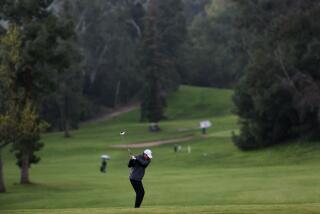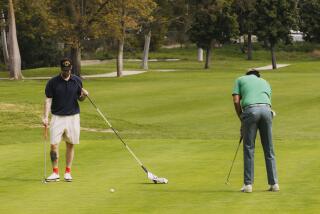The Pro Shop Scramble
After a distinguished career as a club professional, Len Kennett suddenly found many of his friends turning their backs on him, refusing even to speak to him.
And just what evil deed had Kennett done to deserve such treatment? Stolen a golf cart? Insulted a customer? Poured oil in the lakes or concrete in the bunkers of other courses?
Would you believe opened up a golf store?
Seriously.
Watching customers complain about the distances they had to drive to come to his pro shop, seeing the sometimes ludicrous prices consumers had to pay for clubs and other equipment, Kennett opened a golf store on Pico Boulevard in West Los Angeles, one of the first discount shops.
The year was 1972, long before Nevada Bob’s and Roger Dunn became commonplace. In those days, if you wanted to buy top-of-the-line golf equipment, you essentially had one choice: head out to the golf course and check out the pro shop.
Kennett said his venture “was an immediate hit.”
So much so that he soon had three other stores.
Kennett wasn’t golf’s only sales pioneer. Walter Keller was also diverting clubs and balls and gloves from the courses to the city, opening stores for the general consumer.
“It happened much to the chagrin of [those who were used to selling equipment at the golf course],” Kennett said. “Most of my friends stopped speaking to me. But I just figured, if it stayed that way, our friendship wasn’t meant to be.”
Kennett’s plan clearly threatened the stranglehold club pros and those who ran sales operations at the pro shops had on the market.
Kennett didn’t apologize then, and he isn’t about to start now, after having sold all his stores at a profit and returned to his roots as a teacher of the game.
“I’m proud of what I did,” he said. “It’s been good for golf. We have sold first-class equipment to the general public, who was able to purchase it without paying an arm and a leg. I never felt I hurt anyone.”
And why were others so resistant to his innovation?
“To them, it wasn’t traditional to sell golf equipment in stores,” Kennett said. “You know how it is. People are bound by tradition. If this is good for the public, they then should all get on board. Why not drop the prices at the pro shops or match the prices of the downtown stores? There’s no reason why they can’t. It’s just a mind-set.”
If so, it’s a mind-set that has cost pro shops profits from sales that have grown by the billions. Figures vary depending on the organization compiling them, but one thing is clear: Golf sales are way up.
According to the National Golf Foundation, in 1994, the last year for which figures are available, consumers in the U.S. spent $5 billion on golf equipment--about $2.2 billion on clubs, $2.3 billion on items such as balls, gloves and shoes, and another half billion on other accessories. In 1986, the total was $2.1 billion.
And there’s no question where golfers are spending their money. Among those playing 25 or more rounds a year, purchases at pro shops in 1994 were only 17% for balls, 15% for clubs, 14% for golf bags and 14% for apparel. Those playing fewer than 25 rounds a year did even less buying at pro shops in each category.
It is estimated that 20 years ago, those percentages were reversed, that the pro shops cornered about 80% of the market and other outlets the remainder.
“Our margin of profit is not what it used to be,” said David Cink, the head pro at Los Robles Golf and Country Club in Thousand Oaks. “If we’re not competitive these days, we are going to blow the sale. You had better get down in the right price range, or you’re not going to keep the support of your members. Service? Sure, we provide service, but everybody tries to provide service. So price is important.”
But not necessarily everything. Gill Roosmann, head pro at Royal American Links in Galena, Ohio, offers prices in his shop that at least approach those at discount stores, but he also offers a free round of golf for every $100 spent in the shop. That way, he not only provides incentives for sales, he gets consumers to come back.
“And when he comes out to use his pass, he’s going to bring three friends,” Roosmann told PGA magazine. “A lot of guys come out and buy a $120 sweater for their spouse . . . and keep the free round of golf for themselves.”
Added Los Robles’ Cink: “What we have that others, the stores, don’t have is the course. If we are doing our job, there should be people here every day.”
But not every pro-shop salesman takes advantage of that captive audience.
“Some have thrown in the towel,” Cink acknowledged. “They are not as aggressive as maybe they should be.”
But, Cink added, only so much can be done to attract buyers.
“We’re not selling milk,” he said.
Some courses do have a big name to sell. If a golfer wants to boast to his friends that he actually got an opportunity to play at Augusta or Pebble Beach or Riviera or any of the other storied courses in this country, he can’t expect to find a shirt or hat or other item bearing the name of that course at a discount store.
While the stores and the pro shops want to see a steady flow of merchandise crossing the counter, their reasons are not always the same.
“If they don’t sell items, they go out of business,” Ed Anshen, general manager and pro at the Paso Robles Golf and Country Club, said of the discount stores. “They have to make money to pay the rent. They are like a car lot. They have to sell or they are not going to be there. The guy at the golf course wants his customers to be happy so that they will use the golf course over and over again.
“We will match most prices at a discount store unless they are totally outrageous.”
A quarter of a century after some rival pros stopped talking to Kennett, pros find themselves forced to talk more than ever to every golfer who walks in the door simply to keep their ever-shrinking market from disappearing altogether.
How does Kennett feel about that?
“I made golf equipment more affordable to the general public,” he said. “If that’s wrong, I plead guilty.”
Where They Buy
Sales of golf equipment have clearly moved away from golf course pro shops, where barely 20 years ago, an estimated 80% of the equipment was bought. That percentage has been almost reversed today. A look at the percentages of sales at various outlets:
GOLF BALLS
*--*
Where Occasional Moderate Avid Bought Golfers Golfers Golfers Course Pro Shop 13% 13% 17% Golf Retailer 6 14 28 Discount Store 48 47 30 Sporting Goods 14 18 16 Department Store 2 2 1 Mail Order 3 2 1 Other 14 4 8
*--*
GOLF CLUBS
*--*
Where Occasional Moderate Avid Bought Golfers Golfers Golfers Pro Shop 8% 6% 15% Golf Retailer 21 38 46 Discount Store 16 15 8 Sporting Goods Store 23 25 13 Department Store 3 2 1 Mail Order 2 6 7 Other 27 9 10
*--*
Source: National Golf Foundation
More to Read
Go beyond the scoreboard
Get the latest on L.A.'s teams in the daily Sports Report newsletter.
You may occasionally receive promotional content from the Los Angeles Times.









